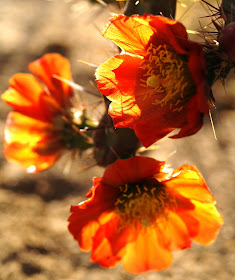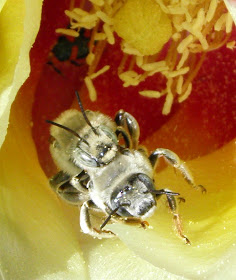 |
| Engelmann's Prickly Pear, Opuntia engelmanni |
 |
| Carpophilus sp. |
I used to think that they are specialized on cacti, but I this week I found clusters of them in Apache Plume (Rosaceae) and in Arizona Thistle (Asteraceae) in Florida Canyon where the cactus flowers were just budding.
 |
| Lasioglossum sp. |
Bees of all sizes are visiting. This small, partly metallic one will hopefully be identified by Monday.
P. s Thanks to John Asher on Bug Guide: he identified the genus as Lasioglossum.
 |
| Cactus Bees, Diadasia sp. |
So this is how the Diadasia couples meet. They share their dating grounds with many other hopefulls. Just check out the depth of the flower behind them, the red and black wing pattern belongs to one of the beetles below
 |
| Clerid beetles Trichodes ornatus |
Clerid beetles Trichodes ornatus come, like the cactus flowers, in red and yellow. But they don't have to match their back ground - the red ones look deceptively like a blister beetle that flies at the same time, the yellow ones imitate wasps.
The two color morphs occur equally among the larger females and the small males, and there seems to be no mating preference related to color. Still, three is a crowd.
 |
| Bruchid Mimosestes amicus |
 |
| Listrus, a dasytin Melyrid |
Where so many insects come together predators will also hang around. Here is one predator stalking another. But the little jumping spider did not attack the tiny Attalus, his aposematic colors may have warned her off.
 |
| Staghorn Cholla Trichopuntia versicolor |
Prickly Pear Cacti (Opuntiae) and their close relatives, the Chollas (Cylindropuntia or in older literature still also Opuntia) dominate our Sonoran desert with an abundance of species. Every day seems to bring new color schemes. But the flowers are all very similar in their simple architecture and they are visited and pollinated by the same army of insects.





So educational and such great photos... thank you!
ReplyDeleteEspecially like the pic of Staghorn Cholla with sun shining thru petals.
ReplyDeleteJust admiring your work and wondering how you managed this blog so well. It’s so remarkable that I can't afford to not go through this valuable information whenever I surf the internet!
ReplyDeleteמדביר ברחובות